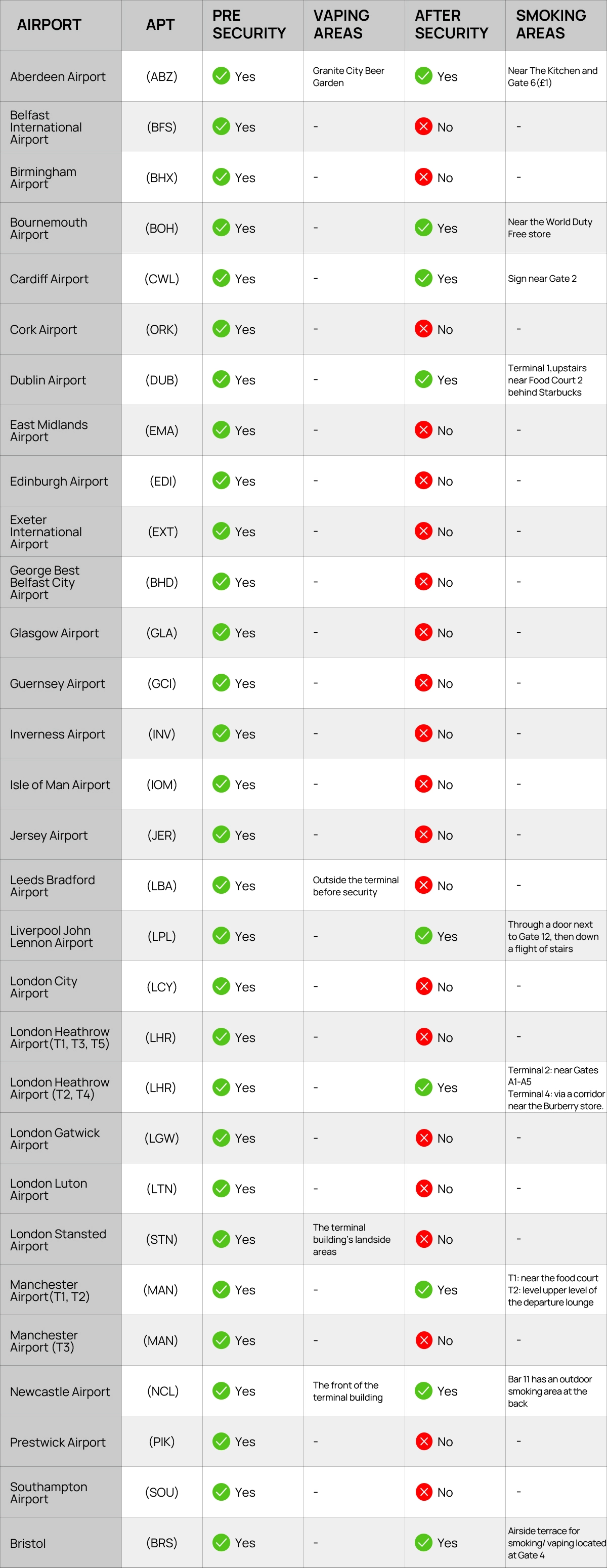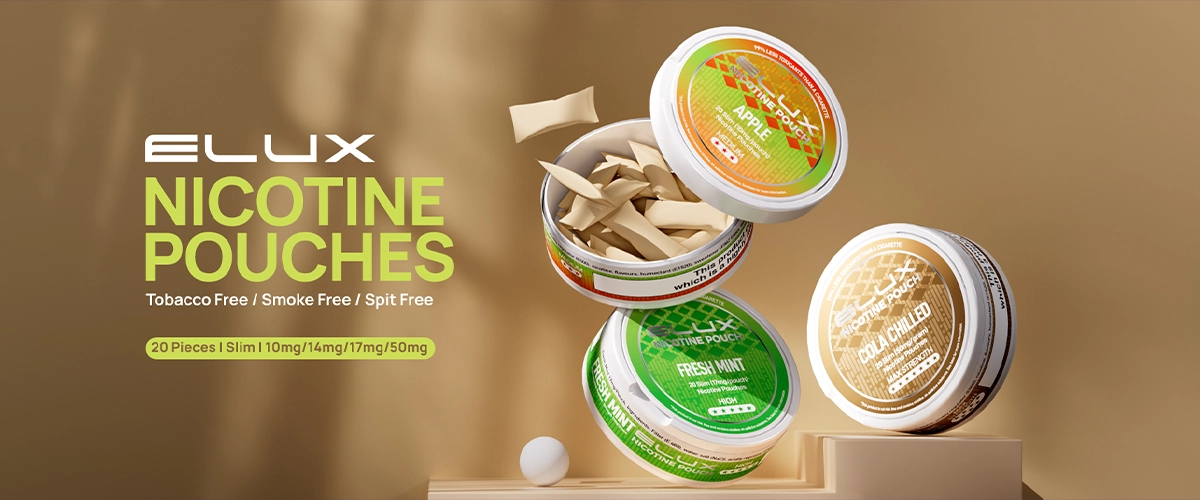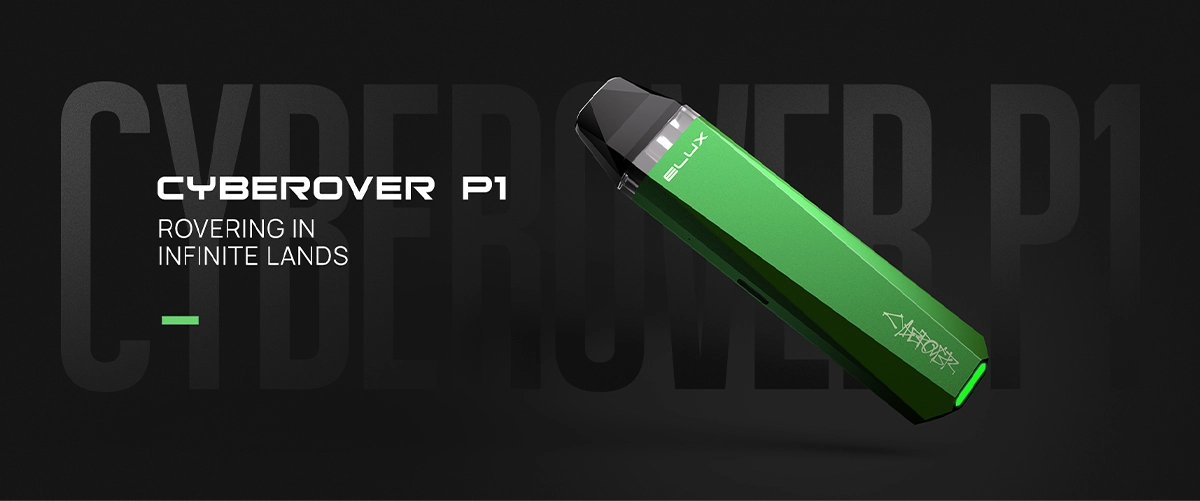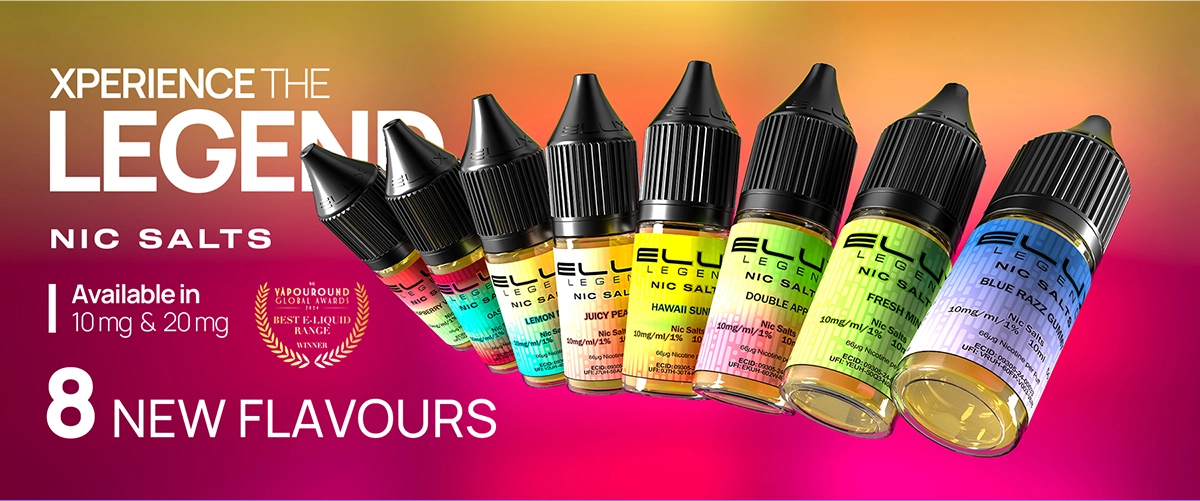WELCOME!
YOU MUST BE 21 YEARS OLD OR ABOVE TO ENTER THIS WEBSITE

WELCOME!
YOU MUST BE 21 YEARS OLD OR ABOVE TO ENTER THIS WEBSITE
Last verified: July 2025. Always check your airline's website before flying, as rules may change.
Yes, you can bring vapes on a plane, but there are strict rules (Including but not limited to UK):

E-liquids are allowed in carry-on luggage only, subject to standard liquid rules. They are not permitted in checked baggage.

Each airline has its own set of rules and regulations regarding travel with vapes. Below, we've outlined the vaping policies of several popular airlines.

Smoking, including the use of personal vaporisers such as vapes, e-cigarettes, e-pipes or any other smoking tool or device, is completely prohibited on board our aircraft, as well as in many airports around the world.
For safety, any smoking/vaping device must be placed in your hand baggage and carried in the cabin. They must also be packaged to prevent accidental activation.
If there are any liquid components to vaporisers, you need to follow aviation security requirements for liquids.
Place the e-liquid – along with any other liquids that you intend to bring aboard – in one clear zip-top plastic bag measuring no more than 8×8 inches and holding no more than a quart. Close the bag fully and place it in your carry-on bag until you reach the airport security checkpoint.
Remove the bag of liquids for separate examination when you reach the airport security checkpoint.
Important note: If you check in your larger cabin bag, or it is removed at the gate to be placed in the hold, you must remove vapes, e-cigarettes or any other smoking devices and carry them with you in the cabin in your smaller hand bag, or on your person for safety.
Pack your e-liquid and all other liquids intended for your carry-on luggage in a single zip-top bag with a volume of no more than one litre. Present the bag separately when passing through the airport security checkpoint.
E-cigarettes and vaping devices, all electronic cigarettes and vaping devices must be carried in the cabin,
re-charging is strictly prohibited and the device must be completely switched off. A maximum of two spare batteries in carry-on baggage is permitted.
Place all of your liquids in a single zip-top bag measuring no more than 8×8 inches.
You can carry no more than 1,000ml of liquids through the security checkpoint. Any liquids exceeding that amount need to be in your checked baggage.
Place all of your liquids in a single zip-top bag measuring no more than 8×8 inches. You can put the bag in carry-on luggage intended for the overhead compartment or under your seat.
Airport security will screen your bag of liquids separately from the rest of your carry-on items.
Flybe does not allow e-liquid bearing a skull-and-crossbones warning label on the package and may confiscate any e-liquid bearing that label.
E-cigarettes may be carried in cabin baggage providing they are individually protected, however please refrain from using these onboard or in the airport (unless in designated smoking areas) as this is prohibited.
Jet2 requires passengers to carry all liquids – including e-liquid – in a single zip-top bag measuring no more than 8×8 inches. Anything that doesn't fit in the bag needs to go in your checked luggage.
Jet2 allows passengers to bring a maximum of two vaping devices each.
You can take e-cigs on the plane but you cannot use them.
You can take a 'smart bag' (a bag that contains a lithium battery and can charge items from the USB port) on the plane as your item of carry-on baggage. However, you must remove the lithium battery before you put the bag in the overhead locker. The battery must stay with you at all times.
You can take up to 15 electronic devices, and up to 20 lithium batteries, onto the plane with you.
Any e-liquids that you wish to carry onboard must be placed in a single zip-top bag measuring no more than 8×8 inches. The bag will be inspected separately from your other carry-on luggage when you reach the airport.
You're not allowed to use electronic cigarettes, or any other portable smoking devices, on the plane – this includes charging. They can be carried on as hand luggage only. You're not permitted to carry e-cigarettes or their spare batteries within your hold luggage.
Carry your e-liquids and all other liquids in a single resealable zip-top bag that you can remove from your carry-on luggage for separate scanning at the security checkpoint. Any liquids that can't fit in a single one-litre bag must travel in your checked luggage.
Electronic cigarettes (including e-cigars, e-pipes, other personal vaporizers) containing batteries must be individually protected to prevent accidental activation.
Any e-liquid and other liquids traveling in your carry-on baggage must be sealed in a zip-top bag measuring no more than 8×8 inches. You'll present the bag of liquids separately from your other carry-on items when you pass through the airport security checkpoint.
The use and charging of all e-cigarettes and other personal vaporisers are not permitted onboard an aircraft.
Must be protected to prevent accidental activation.
The use and charging of all e-cigarettes and other personal vaporisers are not permitted onboard an aircraft.
In general, you cannot vape inside UK airports — but here's a clear breakdown:

Each UK airport may have slightly different rules. Visit the official website of your departure airport (e.g., Heathrow, Gatwick, Manchester) to review their vaping guidelines.
Vaping is strictly prohibited inside terminals, including waiting areas, toilets, and near boarding gates.
Most UK airports provide outdoor smoking areas, usually clearly marked. You must only vape in those designated zones.
According to UK aviation regulations:
![]() E-cigarettes and vape batteries must be in carry-on bags
E-cigarettes and vape batteries must be in carry-on bags
![]() Not allowed in checked luggage
Not allowed in checked luggage
![]() Ensure your device is switched off to prevent accidental activation
Ensure your device is switched off to prevent accidental activation
Vaping on board is illegal and may lead to fines or being denied future travel with the airline.
Your vaping device or e-liquid may be confiscated at security or boarding if stored incorrectly or used in prohibited areas.
Vaping inside terminals or onboard a flight can lead to hefty fines, legal penalties, or being removed from the airport.Denied Boarding or Blacklisting
Using a vape onboard or ignoring crew instructions can result in being denied boarding, ejected from the flight, or banned by the airline.
In serious cases, unauthorized vaping may trigger security alerts, causing flight delays or even emergency landings, which could lead to criminal charges.
Vaping violations may be recorded and shared across airline security databases, affecting future international travel eligibility.
• Always pack your vape device, pods, and e-liquids in your carry-on bag, not checked luggage.
• Lithium batteries are not allowed in checked baggage due to fire risk.
• Switch off the device.
• If it has removable batteries, take them out and store them in a battery case to prevent short circuits.
• E-liquids must follow the 100ml rule for carry-on.
• Max 100ml per bottle.
• All liquids must fit into a transparent 1-liter ziplock bag.
• Cabin pressure changes can cause leaking.
• Empty your tank or store it upright.
• Put tanks or filled pods in a sealed plastic bag or wrap them in tissue.
• Some airlines or countries may have strict rules or bans on vaping gear.
• Check before flying.
• Vaping is not allowed on planes or in most airports.
• Label your gear, especially if traveling with multiple devices or pods — makes security checks smoother.
Go Compact & Lightweight: Choose small, pocket-friendly vapes. Avoid big, complex mods. Go for easy-to-use systems.
Leak-Resistant Design: Look for anti-leak features — especially for flights (cabin pressure may cause leaks). Empty tanks or store upright during travel.
Travel Regulations: Always check airline & country rules. Carry in hand luggage only — lithium batteries are not allowed in checked bags.
Note: Most airline companies allow 15 to 20 disposable vapes, but policies vary — check with your airline to be sure.
Tobacco Free / Smoke Free / Spit Free.
Allow you to use them during the flight.
Don't produce smoke or odour, making them socially friendly.
Use it discreetly, don't draw attention or dispose of it in inappropriate places.

Pocket-sized - Pre-filled pod system with a reusable battery.
6000 Puffs - Long-lasting performance designed to outlast your journey.
Visible E-liquid Container - keep track of your e-juice level at a glance — no more surprises.

Lightweight, leak-proof, and flight-friendly — your perfect travel companion.
Worry-free vaping on the go. Compact enough for your pocket, safe enough for your flight.
Engineered for travel: no leaks, no bulk, just smooth performance.

Lightweight and small size fit easily in a carry-on or pocket.
Nicotine salt formulation for fast absorption and smooth throat hit.
Prevents e-liquid leakage, keeping your luggage and belongings safe.

As the global vaping market continues to grow, laws around its use are rapidly changing. Whether you're a casual vaper or a devoted enthusiast, it's essential to stay informed about what's allowed and what isn't—especially when traveling. In 2025, several countries have introduced new restrictions, while others maintain more relaxed approaches. Here's an updated guide on where you can and can't vape worldwide.
Singapore: Total ban on import, sale, possession, and use of e-cigarettes. Offenders may face heavy fines or imprisonment.
Thailand: Vaping remains illegal, with penalties including confiscation, fines, and even jail time.
Brazil: The sale and advertising of e-cigarettes are prohibited, though personal use is often overlooked.
India: A nationwide ban on production, sale, and distribution of e-cigarettes was implemented in 2019 and remains in place.
Australia: Nicotine e-liquids are classified as prescription-only medications. You must get approval from a doctor to legally purchase or import them.
Japan: Nicotine-containing e-liquids are not sold domestically. Vapers often import them for personal use.
United States: Regulations vary by state and even city. Many states ban vaping in enclosed public spaces and schools. The FDA also regulates products for safety and marketing.
Canada: Vaping laws differ by province, but the sale of nicotine products is legal. Use in public places may be restricted.
France: Vaping is banned in enclosed public spaces and on public transport. Designated vaping zones still exist.
Germany: Vaping is allowed but cannot be advertised to minors. Some public restrictions apply.
United Kingdom: Public Health England continues to endorse vaping as a less harmful alternative to smoking. Sales are regulated but widely accessible.
New Zealand: Strong harm-reduction policies promote vaping to help smokers quit. Use is restricted in schools and some public spaces.
Vaping laws are evolving rapidly. What's legal today may be restricted tomorrow.
Before traveling, always check local regulations to avoid unintentional violations. When in doubt—ask, check signage, or simply avoid vaping in public.
